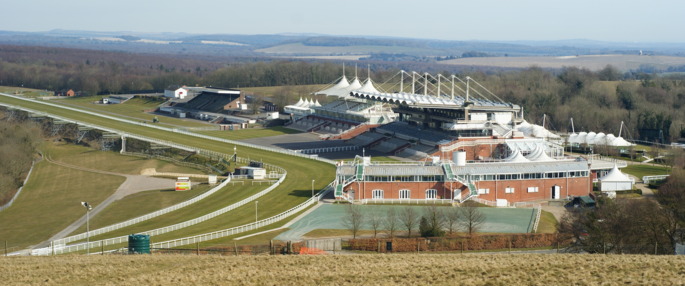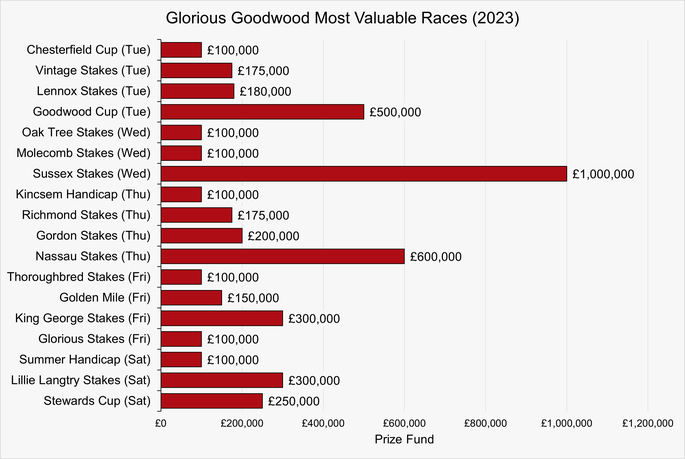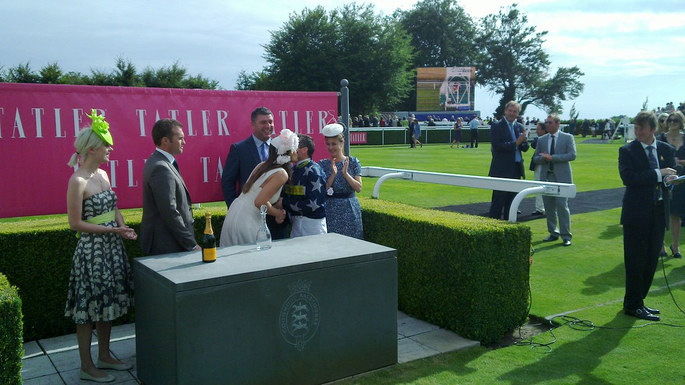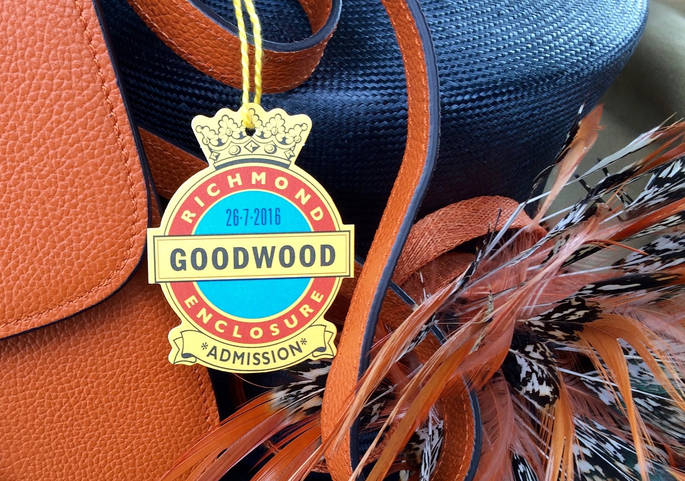Fast Facts
- When: 30th July to 3rd August 2024
- Where: Goodwood, Chichester, West Sussex, PO18 0PX
- Watch: Most races live on ITV
- Official Website: Glorious Goodwood
Glorious Goodwood is one of the highlights of the flat horseracing season held in the UK. Set in the picturesque racecourse of Goodwood, it’s a popular choice for both racing enthusiasts and families.
This five day festival may not have quite the pomp and pageantry of Royal Ascot but many racegoers prefer its slightly more relaxed atmosphere and quintessentially English charm.
It certainly boasts plenty of history of its own, with the first races taking place at the track back in 1802. Since that time this Chichester venue has played hosts to some of the all-time greatest horses: the magnificent Frankel recorded two of his career victories in the showcase race of the week, the Sussex Stakes.
Existing Customer Free Bets & Money Back Offers
Note: Offers will appear here nearer the event as and when they become available.
Event Stats
Goodwood Festival 2023 – Most Successful Trainers
| Trainer | Total Wins | Class 1 | Class 2 | Class 3 |
|---|---|---|---|---|
| John Quinn | 3 | 1 | 1 | 1 |
| Ralph Beckett | 3 | 1 | 1 | 1 |
| Richard Hannon | 2 | 2 | 0 | 0 |
| William Haggas | 2 | 2 | 0 | 0 |
| John & Thady Gosden | 2 | 1 | 1 | 0 |
| Roger Varian | 2 | 1 | 1 | 0 |
| Simon & Ed Crisford | 2 | 1 | 0 | 1 |
| Andrew Balding | 2 | 0 | 2 | 0 |
| David O’Meara | 2 | 0 | 1 | 1 |
| Aidan O’Brien | 1 | 1 | 0 | 0 |
| Hughie Morrison | 1 | 1 | 0 | 0 |
| Michael Appleby | 1 | 1 | 0 | 0 |
| Paul & Oliver Cole | 1 | 1 | 0 | 0 |
| Charles Hills | 1 | 0 | 1 | 0 |
| David Evans | 1 | 0 | 1 | 0 |
| Diego Dias | 1 | 0 | 1 | 0 |
| Dominic Ffrench Davis | 1 | 0 | 1 | 0 |
| Jack Channon | 1 | 0 | 1 | 0 |
| Karl Burke | 1 | 0 | 1 | 0 |
| Richard Fahey | 1 | 0 | 1 | 0 |
| Syd Hosie | 1 | 0 | 1 | 0 |
| Gary Moore | 1 | 0 | 0 | 1 |
| Jamie Osborne | 1 | 0 | 0 | 1 |
Goodwood Festival 2023 – Most Successful Jockeys
| Jockey | Total Wins | Class 1 | Class 2 | Class 3 |
|---|---|---|---|---|
| Tom Marquand | 4 | 4 | 0 | 0 |
| Jason Hart | 3 | 2 | 0 | 1 |
| Andrea Atzeni | 3 | 1 | 2 | 0 |
| Frankie Dettori | 2 | 2 | 0 | 0 |
| Kevin Stott | 2 | 1 | 1 | 0 |
| Rossa Ryan | 2 | 0 | 2 | 0 |
| Oisin Murphy | 2 | 0 | 1 | 1 |
| Jim Crowley | 1 | 1 | 0 | 0 |
| Ryan Moore | 1 | 1 | 0 | 0 |
| Sean Levey | 1 | 1 | 0 | 0 |
| Clifford Lee | 1 | 0 | 1 | 0 |
| David Egan | 1 | 0 | 1 | 0 |
| James Doyle | 1 | 0 | 1 | 0 |
| Jamie Spencer | 1 | 0 | 1 | 0 |
| Jason Watson | 1 | 0 | 1 | 0 |
| Luke Morris | 1 | 0 | 1 | 0 |
| Oisin Orr | 1 | 0 | 1 | 0 |
| Richard Kingscote | 1 | 0 | 1 | 0 |
| Robert Havlin | 1 | 0 | 1 | 0 |
| Hector Crouch | 1 | 0 | 0 | 1 |
| Jack Mitchell | 1 | 0 | 0 | 1 |
| Saffie Osborne | 1 | 0 | 0 | 1 |
| Tom Queally | 1 | 0 | 0 | 1 |
About Glorious Goodwood

The meeting is held at Goodwood Racecourse, which has been voted as one of the best looking courses in the world. It’s owned by the Duke of Richmond and you can see Goodwood House from within the grounds of the track. One of the biggest draws to the event is that it isn’t full of huge grandstands and instead they have created mounds and hills for people to stand on throughout the festival. This means the racing is accessible to all and it’s not just those that can afford it that get to have a good view.
There are two courses that the horses will navigate between, depending on the race. The first is the straight six-furlong sprint course. This is unique in that it’s uphill for the first couple of furlongs, before heading downhill into the finish line, which allows for some very fast and very exciting races.
The second offering is the Craven Course and this is much longer in distance, measuring in at one mile and two furlongs in total. This includes a series of loops and sharp turns that really test a horse’s ability to change direction and follow a specific racing line.
The event takes place in the last week of July or the first week of August and often has an alternative name thanks to sponsorship deals, currently called the Qatar Goodwood Festival. In the end, of course, it’s still the same Festival that we all know and love – Glorious Goodwood.
Format
The meeting is spread out over five days in total, with a mix of high-quality races featuring horses from around the globe.
Glorious Goodwood Races by Day (2023)
| Day | Group 1 | Group 2 | Group 3 | Handicaps | Other | Prize Money |
|---|---|---|---|---|---|---|
| Tuesday | 1 | 2 | 0 | 4 | 1 | £1,145,000 |
| Wednesday | 1 | 0 | 2 | 3 | 1 | £1,445,000 |
| Thursday | 1 | 1 | 1 | 4 | 1 | £1,265,000 |
| Friday | 0 | 1 | 2 | 4 | 0 | £820,000 |
| Saturday | 0 | 1 | 0 | 5 | 1 | £880,000 |
The festival of racing gets underway on the Tuesday, which includes an elaborate opening ceremony. The highlight of the first day of racing comes in the form of now Group 1 Goodwood Cup. This is one of the longest races run over the meeting at two miles, but it’s purse of £500,000 makes it very lucrative for trainers. There is also the £180,000 Group 2 Qatar Lennox Stakes. This race has been won by some massive names from within racing in the past, including both Strong Suit and Observatory.
Day Two sees a standout race in the form of The Qatar Sussex Stakes (British Champion Series), which is a Group 1 race. The race is run over one mile and includes a purse of £1 million, making it one of the richest flat races in the UK. There is also two Group 3 races in the Oak Tree Stakes and the Molecombe Stakes.
The Thursday is Ladies Day, and a chance for people to dress up in their Sunday Best. The pick is the Qatar Nassau Stakes, which is a Group 1 offering. The racing doesn’t stop there though, with the Group 2 Richmond Stakes and Group 3 Gordon Stakes.
The penultimate day of the meeting is arguably the pick of the days in terms of the total quality of racing on offer. It includes three group races that are the King George Stakes, the Glorious Stakes and the Thoroughbred Stakes as well as the valuable Golden Mile handicap.
The meeting comes to a close on the Saturday with an atmosphere that is more akin to a party than a racing day. That said, it still includes the Group 2 Lillie Langtry Stakes and the Qatar Stewards’ Cup Handicap.

A Closer Look at the Key Races

Five days of racing is a lot to take in, particularly if you’re trying to talk about it briefly. Glorious Goodwood is a festival of racing that merits being spoken about in more detail, so here’s a quick look at some of the major races from during the week:
The Goodwood Cup
| First Run | Distance | Grade | Fastest Recorded Winner |
|---|---|---|---|
| 1812 | 2 Miles | Group 1 | Yeats (2006) |
Inaugurated in its current form in 1812, a race with the same name was actually created four years earlier. There was a silver cup on offer to the winner but it was given to Bucephalus’s owners after the horse won it three times, hence the need for a new one to be created. Originally run over three miles, it was dropped down to two miles and five furlongs and now takes place over two miles precisely.
Initially classed as a Group 2 race, it dropped to Group 3 in 1985 and then returned to Group 2 ten years later. The move to Group 1 occurred in 2017, making it one of the most prestigious races for flat racing stayers that there is. Open to horses aged three and up, Stradivarius is the most successful horse with four wins ahead of Double Trigger with three wins. Six jockeys have won the race five times apiece, whilst John Scott is its most successful trainer thanks to his seven wins. Along with the Gold Cup at Ascot and the Doncaster Cup, this is part of the Stayers’ Triple Crown.
The Molecomb Stakes
| First Run | Distance | Grade | Fastest Recorded Winner |
|---|---|---|---|
| 1829 | 5 Furlongs | Group 3 | Trillium (2022) |
This race was first run in 1829, which gives you an indication about the history of the racecourse. Another indication comes in the form of what the race is named after – a house on the estate that the Third Duke of Richmond built for his sister. Having originally been for two-year-old horses of either gender, the race was limited to just fillies in 1932 before being opened back to colts and geldings in 1981.
Taking place over five furlongs, the Group 3 race can reach some impressive speeds. The horse have a weight of nine stone one pound, with a three pounds allowance for fillies. The race’s most successful jockey of all-time is a man whose name you’ll read a few more times before this piece is over: Lester Piggott. He won eight races, which is one more than the most successful trainers in the race, John Barham Day and John Porter.
The Nassau Stakes
| First Run | Distance | Grade | Fastest Recorded Winner |
|---|---|---|---|
| 1840 | 1 Mile 2 Furlongs | Group 1 | Deirdre (2019) |
One of the most prestigious races during Glorious Goodwood is the Nassau Stakes. Established in 1840 as a race for three-year-old fillies, it was opened up to both fillies and mares aged three and over in 1975. Originally it took place over one mile and was extended to one and a half miles in 1900. Eleven years later it changed again to take place over one mile, one furlong and one hundred and ninety-seven yards.
The title might seem unusual, but it acknowledges the 5th Duke of Richmond’s relationship with the house of Orange-Nassau. A Group 2 race for a time, it moved to be a Group 1 offering in 1999. The most successful horse in the race’s history is Midday who won three times back-to-back in 2009, 2010 and 2011. Nat Flatman and Sir Gordon Richards have both enjoyed six wins as jockeys, with Sir Henry Cecil being the most successful trainer thanks to his eight wins.
The Sussex Stakes
| First Run | Distance | Grade | Fastest Recorded Winner |
|---|---|---|---|
| 1841 | 1 Mile | Group 1 | Aljabr (1999) |
Sir Gordon Richards has won this race eight times, making him the most successful jockey. That’s one more victory than the race’s most successful trainer, Sir Henry Cecil, managed. There have been a couple of versions of the race, with the first being a six furlong event that was open to two-year-olds when it was established in 1841. In 1878 it became a one mile race for horses a year older and it remained that way until 1960 when it was for horses aged four and over.
In 1975 the race changed again, this time being for horses aged five and up. Nowadays it’s an event for those aged three and over, suggesting that organisers still aren’t sure what they want it to be in spite of the fact that it’s considered to be one of the most prestigious races that takes place at Glorious Goodwood. It wasn’t always that way, with the Stewards’ Cup and Goodwood Cup overshadowing it until it took on its current format. Despite running for so long, only Frankel has won the race more than once.
The Richmond Stakes
| First Run | Distance | Grade | Fastest Recorded Winner |
|---|---|---|---|
| 1877 | 6 Furlongs | Group 2 | Royal Scotsman (2022) |
Given that we have the Lennox Stakes and the Gordon Stakes, it shouldn’t come as a surprise that the Duke of Richmond’s main title also has a race named in its honour. First run in 1877, Fred Archer remains one of the two most successful jockeys in the race having won it on six of the first eight occasions that it took place. He’s since been joined by Lester Piggott and his work also made Mathew Dawson one of the most successful trainers thanks to five of the six wins being horses from his stable. Richard Hannon Sr. is the other trainer who has won the race five times.
Originally open to horses of either sex, the race is limited to two-year-old geldings and colts nowadays. That restriction was introduced in 1989 to this race that takes place over six furlongs and has a weight of nine stone attached to it. The Group 2 event has seen previous winners go on to win one of the Classics in the next season. That said, that’s not something that you should get too hung up on considering that the most recent horse to do so was Palestine, which won this race in 1949 and then the 2,000 Guineas the following year.
The Gordon Stakes
| First Run | Distance | Grade | Fastest Recorded Winner |
|---|---|---|---|
| 1902 | 1 Mile 4 Furlongs | Group 3 | Cross Counter (2018) |
Open to three-year-olds, the Gordon Stakes was first run back in 1902. As with the Lennox Stakes, this race is named after one of the Dukedoms that is held by Goodwood Racecourse’s owner, the Duke of Richmond. A year after it was inaugurated the age of entrants was restricted and that has remained in place since. Given the race’s title, it’s noteworthy that one of the two most successful jockeys is Sir Gordon Richards, with the other being Willie Carson.
Both jockeys won the race six times, whilst the most successful trainer, Sir Michael Stoute, has won it ten times at the time of writing. Racing fans often like to know about what a race can tell them about future events, so you might be interested to learn that nine horses have gone on to win the St. Leger Stakes after winning this. It is run over one mile, three furlongs and two hundred and eighteen yards.
The King George Stakes
| First Run | Distance | Grade | Fastest Recorded Winner |
|---|---|---|---|
| 1911 | 5 Furlongs | Group 2 | Battaash (2020) |
This Group 2 race first took place in 1911 and is open to horses aged three and over. Lasting for a distance of five furlongs, it was created in order to honour the coronation of King George V. When the grading of races in its current format first came in 1971, the race was immediately made a Group 3 offering and achieved Group 2 status in 2010. It has enjoyed several sponsors over the years, including the car manufacturer Audi from 2005 until 2011.
Battaash is the most successful horse in this race with four wins in 2017, 2018, 2019 and 2020 and also holds the record for the fastest time run. There are six different horses that have won the race twice. When it comes to the race’s most successful jockey, it’s that man Lester Piggott again who’s notched up nine wins. Charles Hills has managed five wins as trainer, four of which with Battaash This is one more than Jack Jarvis and Paddy Prendergast who have trained four winners each. If you’re wondering if this race informs another one then to an extent it does. Competitors often go on to race in the Nunthorpe Stakes, Battaash was the last winner of the two in the same year in both 2019 and 2020, with Lochsong the previous winner of this double which she achieved in 1993.
The Vintage Stakes
| First Run | Distance | Grade | Fastest Recorded Winner |
|---|---|---|---|
| 1975 | 7 Furlongs | Group 2 | Ekraar (1999) |
Run over seven furlongs, the Vintage Stakes was inaugurated in 1975 as a Listed event. It was known as the Lanson Champagne Vintage Stakes because of sponsorship. For some reason champagne companies have long considered this to be a good race to sponsor, with Veuve Clicquot taking over the sponsorship duties in 2003.
The shift from being a Listed race to being classed in Group 3 came about in 1986, with the move to Group 2 happening when Veuve Clicquot became its sponsor. Two people, Dick Hern and Sir Henry Cecil, have trained six winners apiece, whilst Frankie Dettori and Willie Carson have had the same number of wins to make the the most successful jockeys. If you’re wondering what this race can tell you about the future then bear this in mind: some past winners have gone on to win one of the Classics the following year.
The Oak Tree Stakes
| First Run | Distance | Grade | Fastest Recorded Winner |
|---|---|---|---|
| 1980 | 7 Furlongs | Group 3 | Billesdon Brook (2019) |
Open to fillies and mares aged three or over, only Al Jazi has won the race more than once. Interestingly, none of Steve Cauthen’s four wins as a jockey nor Sir Henry Cecil’s six wins as a trainer came courtesy of the horse. The race was inaugurated in 1980 as the New Stand Stakes. That was because it was originated in order to commemorate the new stand that had been opened by the Queen. The year after its inauguration it took place on the same day as Prince Charles’s marriage to Diana and was renamed as the Royal Wedding Day Stakes.
It didn’t make a huge amount of sense for the race to keep that name, of course, so it became the Oak Tree Stakes the year after as a nod to Goodwood’s link to the Oak Tree Racing Association. There was a Goodwood Stakes that took place at the Santa Anita Park venue until it was renamed as the Awesome Again Stakes in 2012. Having been a Listed race since its origin, the event became a Group 3 offering in 2004.
The Lennox Stakes
| First Run | Distance | Grade | Fastest Recorded Winner |
|---|---|---|---|
| 2000 | 7 Furlongs | Group 2 | Dutch Connection (2016) |
The Duke of Richmond is the owner of Goodwood Racecourse and is also known as the Duke of Lennox, which is where this race gets its name from. It’s one of the youngest run during Glorious Goodwood, having been established in 2000. Six different jockeys have won the race twice to date, with seven trainers having won it twice. As the race is open to three-year-olds and up, the same horse can win it more than once. Interestingly though, only three have – Nayyir in 2002 and 2003, Sir Dancealot in 2018 and 2019 and Kinross in 2021 and 2023.
The race was created after the Beeswing Stakes at Newcastle was discontinued in 1999. It was originally a Group 3 race but became a Group in 2003. If you’re a fan of Goodwood but don’t recognise the name of the race then it might be because it has enjoyed sponsorship over the years since it was inaugurated. From 2004 until 2010, for example, it was known as the Betfair Cup.
The Lillie Langtry Stakes
| First Run | Distance | Grade | Fastest Recorded Winner |
|---|---|---|---|
| 2003 | 1 Mile 6 Furlongs | Group 2 | Meeznah (2011) |
Known as the Gladness Stakes when it was first created as a Listed race in 2003, the event got its current name in the year after. That was also the moment that it became a Group 3 race. Lillie Langtry, if you’re wondering, was a British actress who was the mistress of King Edward VII and the owner of Merman, a horse that won the Goodwood Cup in 1899.
Again, casual fans of Goodwood might not recognise the name of the event, which is down to the fact that it has enjoyed numerous sponsors over the years and often taken on their names. Having been promoted to become a Group 2 race in 2018, the race is open to fillies and mares aged three and up. Tartouche, Wild Coco and Enbihaar have all won the race twice, leading to Tom Queally, Seb Sanders and Jim Crowley being the most successful jockeys with three wins each in total. John Gosden has trained three winners with Lady Herries and Sir Henry Cecil have trained two winners each.
Interesting facts

More than one hundred thousand people ascend on Goodwood Racecourse over the five days, making it one of the most popular race meetings across Europe.
The event hosts some of the biggest Group 1 races in the UK and with that comes the biggest and best flat racing jockeys and trainers from around the globe.
It’s a course that has much more to tell you about than that, though, with the following being some of the most interesting information out there:
- The Festival was original just two days long and was lengthened when it was moved to the end of July in 1814
- The venue is associated with the Panama hat, which was first won at Goodwood in 1907
- The Festival’s longest race is two miles and five furlongs, the Goodwood Handicap
- Around sixty thousand racecards are printed for the Festival of racing
- There’s a helicopter pad on site, which usually hosts around 150 landings and take-offs over the five days
- About forty thousand jugs of Pimms are consumed during the week
